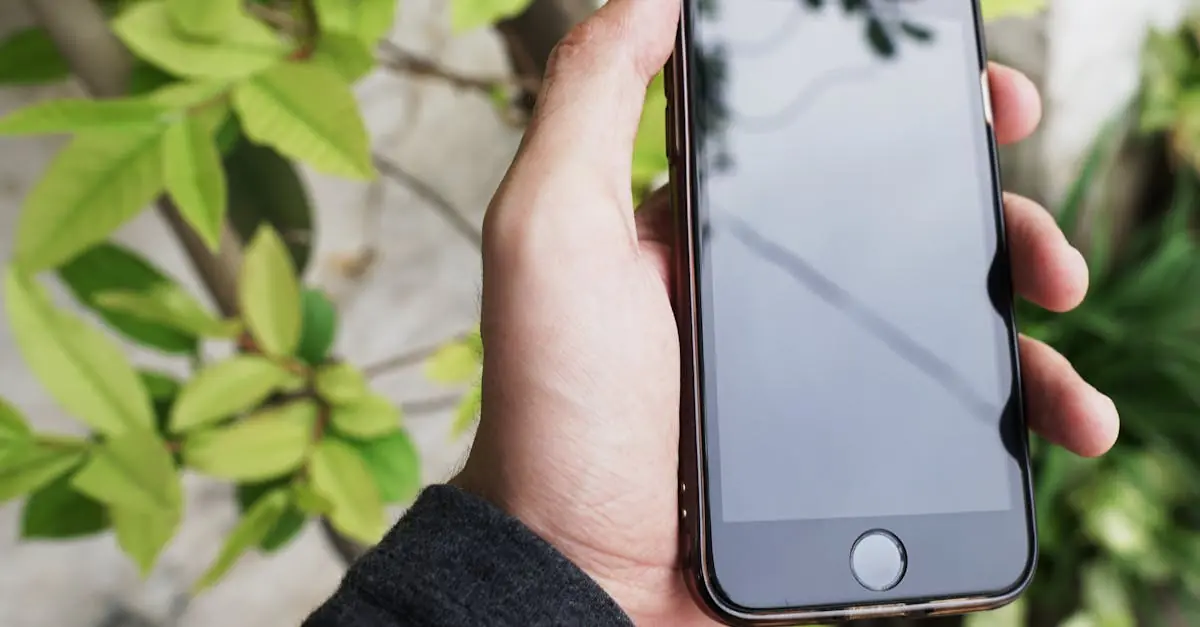Unlocking your iPhone shouldn’t feel like cracking a safe at a heist movie. Yet, many find themselves staring at a screen lock that feels more like a fortress than a simple security feature. Whether it’s a forgotten passcode or a sudden urge to ditch that pesky lock, the need to take off the screen lock is real and relatable.
Table of Contents
ToggleOverview of Screen Locks
Screen locks serve as essential security features for iPhones, preventing unauthorized access to personal data. Various types of screen locks exist, including passcodes, Touch ID, and Face ID. Many users rely on these methods to safeguard their sensitive information and maintain privacy.
Passcodes consist of numerical combinations or alphanumeric phrases, typically ranging from four to six digits. Users can personalize passcodes to enhance security. Touch ID utilizes fingerprints for quick access, while Face ID employs facial recognition technology to unlock devices seamlessly.
The importance of screen locks cannot be overstated. They protect against data theft and unauthorized usage, especially in social or public settings. Users may encounter situations where forgetting their passcode becomes a frustrating barrier to access. In such cases, individuals might seek to disable their screen locks to regain control of their devices.
Removing a screen lock requires specific steps and varies depending on the type of lock in use. Users looking to disable their lock may need to reset their device or use recovery modes for passcodes. With the right approach, regaining access to an iPhone without a screen lock becomes achievable.
While screen locks provide considerably enhanced security, users should evaluate their personal preferences when choosing the right method. Understanding the different options available will help users make informed decisions tailored to their needs. Overall, screen locks remain a vital aspect of iPhone security, balancing convenience and protection.
Types of Screen Locks
Users encounter different types of screen locks on iPhones, each serving a unique purpose in security and convenience. Understanding these options helps in selecting the right method for personal needs.
Passcode
Passcodes provide a straightforward way to secure an iPhone. Users can set a four to six-digit number that must be entered to unlock the device. Customization allows personalization, enabling users to select memorable combinations. Forgotten passcodes create challenges, leading to frustration and potential lockouts. Bypassing this issue involves remembering or resetting the passcode through recovery methods.
Touch ID and Face ID
Touch ID and Face ID deliver quick and secure access through biometric technology. Touch ID scans a user’s fingerprint for swift unlocking, promoting convenience for daily use. Face ID utilizes facial recognition, allowing users to unlock with just a glance. Both methods enhance security while minimizing effort in accessing the device. Preference between these options often depends on comfort and user experience. Each option plays a critical role in safeguarding sensitive information while offering easy access for legitimate users.
Methods to Take Off Screen Lock
Removing a screen lock on an iPhone can be straightforward. Several methods exist depending on the lock type and user preferences.
Using Settings
Accessing the screen lock option through Settings offers a simple approach. Open the Settings app, select “Face ID & Passcode” or “Touch ID & Passcode.” Enter the current passcode, then scroll to the option labeled “Turn Passcode Off.” Confirm the action by tapping “Turn Off.” This process effectively disables the screen lock, granting easier access to the device.
Using iTunes
Using iTunes to remove the screen lock requires a computer. Connect the iPhone to the computer and launch iTunes. While iTunes recognizes the device, select “Summary” and click on “Restore iPhone.” This action erases the device entirely, including the passcode, restoring it to factory settings. After the process completes, set up the iPhone as new or restore from a backup.
Using iCloud
iCloud offers a remote solution for unlocking a device. Log into iCloud.com with the associated Apple ID. Navigate to “Find iPhone,” select the device in question, and click “Erase iPhone.” This method removes all data, including the lock screen passcode. Afterward, users can set up the device as new or restore from a backup, ensuring access to previously stored information.
Troubleshooting Common Issues
Users often encounter several issues when attempting to remove a screen lock on their iPhones. Forgotten passcodes frequently lead to frustration and possible lockouts. When this happens, the first course of action involves verifying if the passcode entered is correct. Repeated failed attempts could result in the device becoming disabled temporarily.
In cases where Touch ID or Face ID aren’t functioning as expected, ensure that the user’s face is unobstructed or fingers are clean and dry. Adjustments to settings might also be necessary if these features fail to recognize the user. Users should re-enroll their fingerprints or reset Face ID for the best performance.
Forgotten Apple IDs can complicate the unlocking process. Users looking to reset their passcodes might need to confirm their identity via the Apple ID account page. If they cannot retrieve this information, Apple support provides guidance to regain access.
Another common issue arises during the factory reset via iTunes. Users must confirm their devices are updated to ensure smooth restoration processes. A faulty USB cable or outdated iTunes version can hinder progress. Connection issues can often cause data loss, so ensuring a stable connection is vital.
For those relying on iCloud, users should verify the device is registered to their Apple ID. If not, remote erasure cannot occur. Proper internet connectivity is essential during this process as sporadic issues may interrupt the remote erase.
Frequent errors can impede access to devices. Following the correct procedure for the chosen unlocking method helps minimize complications. Checking settings and ensuring minimum requirements can lead to successful unlocking outcomes.
Removing a screen lock on an iPhone can be a straightforward process when users understand their options. Whether it’s through the Settings app, iTunes, or iCloud, each method offers a unique approach to regaining access. Users must carefully consider their security needs and preferences when selecting a screen lock method to ensure both convenience and protection of personal information.
By following the outlined steps and troubleshooting tips, users can navigate the unlocking process with confidence. Ultimately, being informed about these options empowers users to manage their devices effectively while maintaining the security that screen locks provide.



